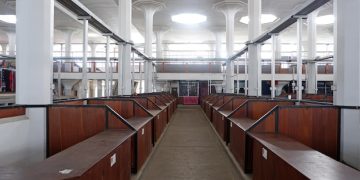Teacher Shortage Crisis: New Report Reveals 15% Increase in US Public Schools

A new report highlights a concerning trend: a 15% surge in teacher shortages across US public schools, significantly impacting student learning and educational quality, particularly in underserved communities.
The repercussions of nationwide teacher shortages are coming into sharper focus as a new report reveals a 15% increase in teacher shortages across US public schools. This rise has profound implications for the education system.
Understanding the Scope of Teacher Shortages in the US
Teacher shortages have become a persistent challenge in the American education system, affecting schools across various regions and demographics. Quantifying the extent of these shortages is crucial for devising effective intervention strategies.
Key Findings from the New Report
The recent report sheds light on several critical aspects of the teacher shortage problem. It goes beyond mere numbers to explore the nuances and regional disparities within the data.
- National Increase: The report indicates a 15% increase in teacher shortages nationwide, compared to the previous academic year.
- Regional Disparities: The shortages are not evenly distributed. States in the South and Southwest are experiencing more acute shortages than those in the Northeast.
- Subject-Specific Needs: Certain subjects, such as math, science, and special education, are facing more severe shortages than others.
These findings underscore the urgency of addressing the root causes of teacher shortages. Without proactive measures, the quality of education in US public schools could be severely compromised.

The Underlying Causes of Teacher Shortages
Understanding the factors contributing to the alarming teacher shortages is paramount. These causes are multifaceted, involving not only economics but also professional and social dynamics.
Low Salaries and Lack of Incentives
One of the primary drivers of teacher shortages is the relatively low compensation offered to educators. Compared to other professions requiring similar levels of education, teachers often earn less.
This discrepancy becomes even more pronounced when considering the rising cost of living and student loan debt. Many qualified individuals may be deterred from entering or remaining in the teaching profession due to financial constraints.
Burnout and Workload
High workloads, increasing administrative duties, and lack of adequate resources contribute to teacher burnout. Many educators report feeling overwhelmed and unsupported.
This often leads to decreased job satisfaction and, ultimately, departure from the profession. Addressing these systemic issues is essential for retaining qualified teachers.
The Impact on Students and Schools
The consequences of teacher shortages extend far beyond administrative challenges, directly affecting the education and well-being of students. The effects are particularly pronounced in underserved communities.
Teacher shortages can lead to larger class sizes, reduced access to specialized support, and increased reliance on less qualified instructors. These factors can hinder student achievement and overall academic growth.

Strategies to Mitigate Teacher Shortages
Addressing the crisis requires a comprehensive approach that involves government, educational institutions, and community stakeholders. Several innovative solutions are being explored and implemented across the country.
Increased Teacher Compensation
Raising teacher salaries is a fundamental step toward attracting and retaining talented educators. Competitive compensation packages can make the profession more appealing.
In addition to salary increases, providing financial incentives such as student loan forgiveness programs and housing assistance can further alleviate the financial burden on teachers.
Enhanced Professional Development and Support
Investing in high-quality professional development programs can improve teacher effectiveness and job satisfaction. Offering mentorship opportunities and creating supportive work environments can also reduce burnout.
These measures not only benefit teachers but also contribute to improved student outcomes. A well-supported teaching staff is more likely to remain committed to their profession.
Case Studies: Schools Successfully Addressing Shortages
Examining success stories can provide valuable insights into practical strategies for tackling teacher shortages. Several schools and districts have implemented innovative programs to attract and retain teachers.
Targeted Recruitment Programs
Some schools have developed targeted recruitment programs aimed at attracting diverse candidates. These programs often involve partnerships with local universities and community organizations.
- Mentorship Programs: Pairing new teachers with experienced mentors for guidance and support.
- Residency Programs: Offering hands-on training and classroom experience to aspiring teachers.
- Community Engagement: Building strong relationships with local communities to foster a sense of belonging and support.
These approaches not only increase the number of available teachers but also enhance the quality of instruction.
Innovative Scheduling and Resource Allocation
Creative scheduling and resource allocation can help maximize the impact of existing teaching staff. This may involve using technology to deliver instruction or reorganizing class structures.
By optimizing resources and leveraging technology, schools can effectively address teacher shortages without compromising educational quality.
The Role of Policy and Advocacy
Policy changes at the state and federal levels are essential for addressing teacher shortages on a broader scale. Advocacy efforts can play a crucial role in driving these changes.
Advocating for increased funding for education, improved working conditions for teachers, and streamlined certification processes can make a significant difference.
| Key Point | Brief Description |
|---|---|
| ❗ Shortage Increase | US public schools face a 15% increase in teacher shortages. |
| 💰 Low Salaries | Low compensation is a major cause, deterring potential educators. |
| 🔥 Teacher Burnout | High workloads and lack of support lead to teacher burnout and turnover. |
| 📚 Impact on Students | Shortages result in larger classes and reduced access to resources. |
Frequently Asked Questions
▼
The report indicates a significant 15% increase in teacher shortages across US public schools, highlighting a growing crisis within the education system.
▼
Key factors include low salaries, high levels of burnout due to heavy workloads, and a general lack of adequate support for educators in many school districts.
▼
Shortages can lead to larger class sizes, reduced access to specialized support services, and an increased reliance on less experienced or qualified instructors.
▼
Potential solutions involve raising teacher salaries, improving working conditions, providing more professional development opportunities, and promoting policies that support educators.
▼
Subjects such as mathematics, science, and special education tend to experience more severe shortages than other disciplines, requiring targeted recruitment efforts.
Conclusion
The new report highlighting the 15% increase in teacher shortages across US public schools underscores the importance of addressing this issue with urgency and comprehensive strategies. By recognizing the multifaceted nature of the problem and implementing targeted solutions, we can ensure that all students have access to high-quality education.





